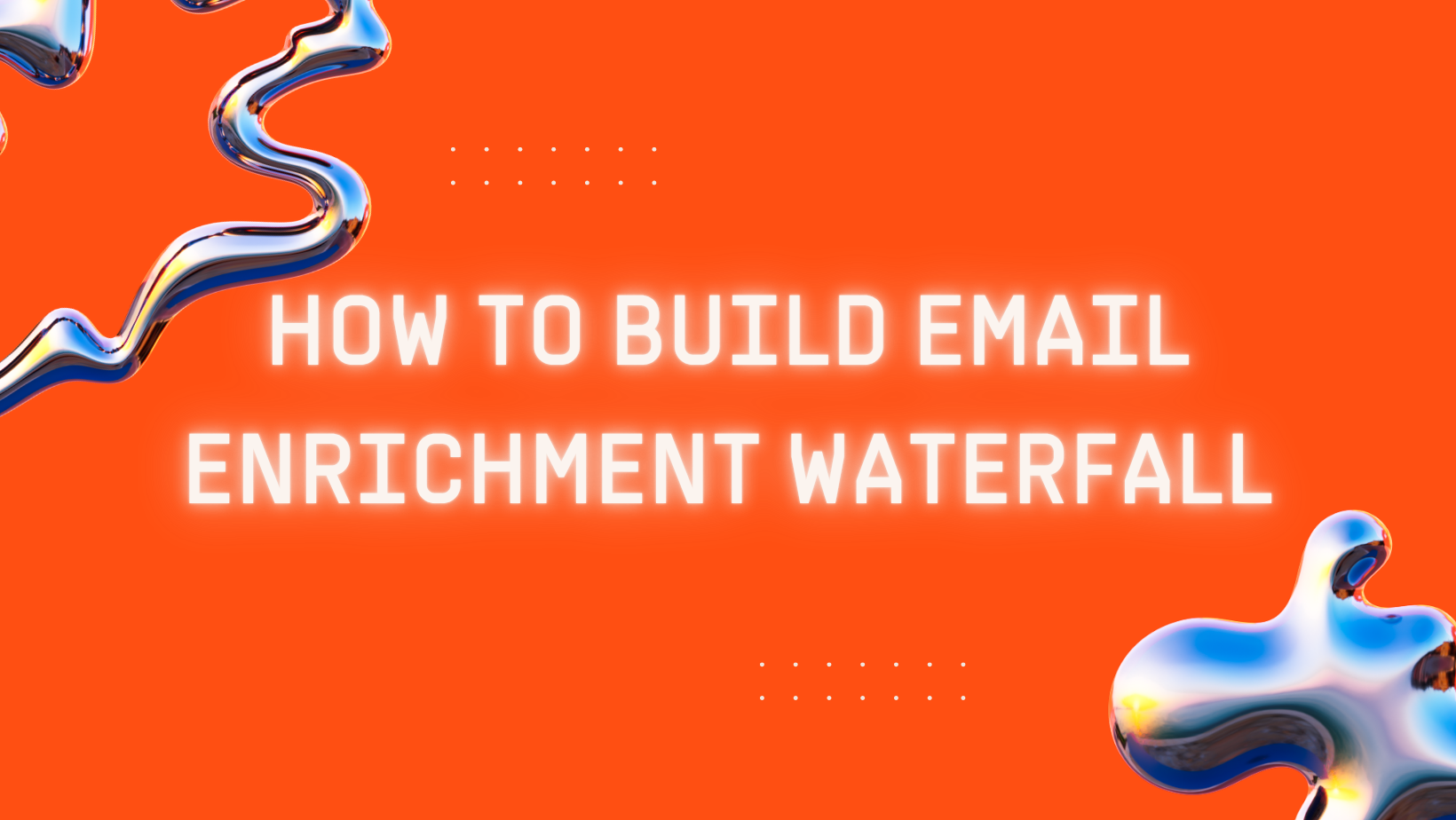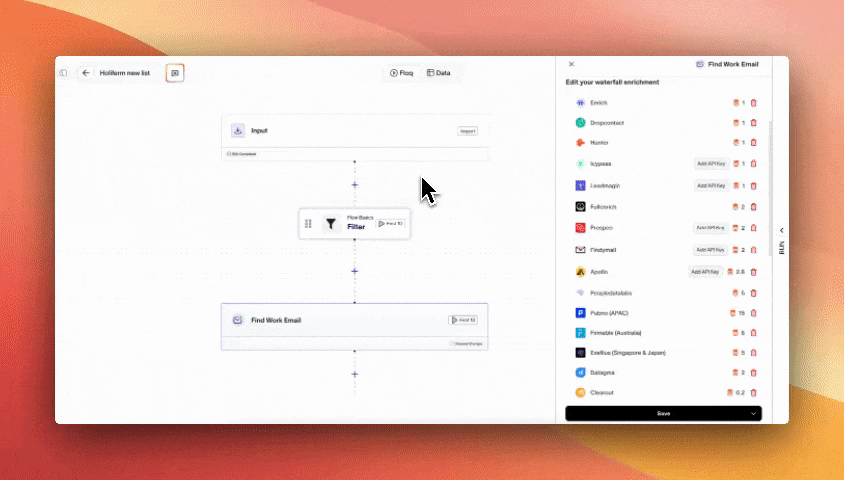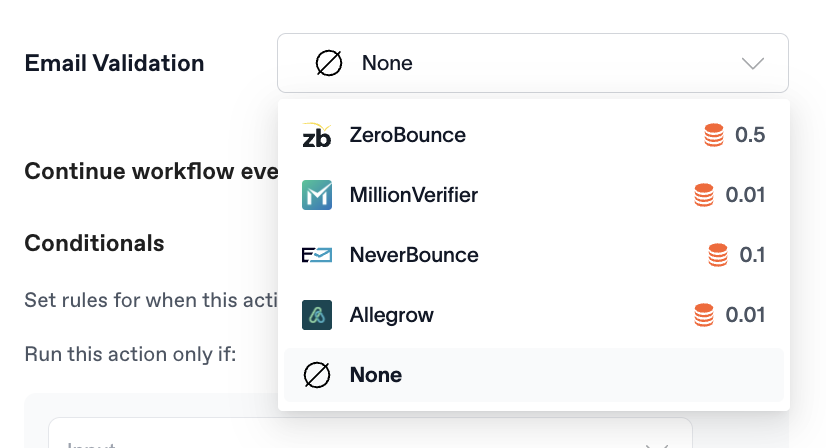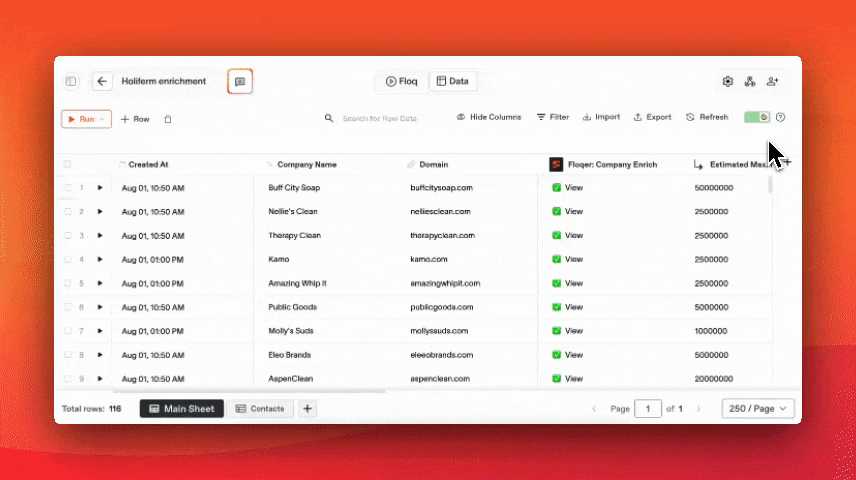How to build a work email enrichment waterfall

Most companies waste 60-70% of their email enrichment budget by using a single premium provider for everything. A better approach? Build an enrichment waterfall that cascades through multiple data sources, starting with the cheapest and only escalating to expensive providers when necessary.
A CRM data enrichment waterfall is like a procurement strategy for finding work emails – you wouldn't buy all your office supplies from the most expensive vendor, so why do that with contact data?
In this guide, you'll learn how to build a cost-efficient email enrichment waterfall that maintains data quality while slashing costs.
TL;DR
An email enrichment waterfall queries multiple data providers sequentially, starting with the cheapest sources and escalating only when needed. Instead of paying $2.80+ per email for everything, you pay $0.20-1.00 for 70% of emails and reserve premium pricing for the remaining 30%.
Results: 60-70% cost reduction, 20-30% better email coverage, zero vendor lock-in.
The sequence: Your existing data → Budget providers → Mid-tier → Premium providers
What is an email enrichment waterfall?
An email enrichment waterfall is an automated system that tries multiple data sources in order of cost-efficiency, stopping when it finds a verified work email.
Think of it like a reverse auction for each contact:
Check if you already have the email (free)
Try predicting the email using company patterns (almost free)
Query Clearout ($0.20)
If that fails, try Hunter, Dropcontact, or Icypeas ($1.00)
Still nothing? Use Enrich, Findymail, Prospeo, or Datagma ($2.00)
Last resort: Apollo ($2.80), Peopledatalabs or Exellius ($5.00), Firmable ($8.00), or Pubrio ($15.00)
The key insight: Most work emails can be found with cheaper sources. You only need premium providers for 20-30% of your contacts – typically executives at large companies or edge cases where budget providers have gaps.
Why this matters
Traditional approach: Pay Apollo $2.80 per credit for every contact, spending $140K annually to enrich 50K emails.
Waterfall approach:
25K emails found via Clearout at $0.20 = $5K
10K emails found via Hunter at $1.00 = $10K
8K emails found via Findymail at $2.00 = $16K
5K emails found via Apollo at $2.80 = $14K
2K emails found via Peopledatalabs at $5.00 = $10K
Total: $55K (61% savings)
The math is compelling. The execution is where most teams struggle – until now.
11 core email enrichment data sources
Floqer aggregates 80+ email enrichment providers in one platform, so you can build waterfalls using any combination of sources without managing multiple subscriptions. You can add your own APIs if needed too.
Here are the key providers available, grouped by their strengths:
Budget email finders – best for volume
Clearout ($0.20) - Most affordable option, excellent for high-volume
Hunter ($1.00) - Strong domain search, good for tech companies
Dropcontact ($1.00) - GDPR-compliant, strong European data
Icypeas ($1.00) - Good LinkedIn integration
Leadmagic ($1.00) - Real-time email discovery
Best for: High-volume prospecting, top-of-funnel, when cost matters most.
Mid-Tier providers – balance of cost & coverage
Enrich ($2.00) - Solid B2B coverage
Findymail ($2.00) - Excellent catch-all detection, real-time verification
Prospeo ($2.00) - LinkedIn-focused email finder
Fullenrich ($2.00) - Multi-source waterfall built-in
Datagma ($2.00) - Comprehensive data enrichment
Best for: Target accounts, when budget providers fail, harder-to-find contacts.
Premium multi-source – highest coverage
Apollo - Best-in-class B2B database, extensive coverage
Prospeo - LinkedIn-focused email finder
Peopledatalabs - Enterprise-grade data with deep coverage
Best for: C-suite emails, enterprise accounts, when all else fails
Specialty Providers
Apollo ($2.80) - Best-in-class B2B database, extensive coverage
Peopledatalabs ($5.00) - Enterprise-grade data with deep coverage
Exellius ($5.00) - Strong coverage for Singapore & Japan markets
Firmable ($8.00) - Specialized for Australian market
Pubrio ($15.00) - Premium APAC coverage
Best for: C-suite emails, enterprise accounts, region-specific leads, when all else fails
The beauty of Floqer is you can mix and match any of these 80+ sources in your waterfall based on your specific needs – all from one platform, one interface, with unified credit tracking.
How to build your email waterfall in 5 steps
Import your contact list
Upload a CSV, build a new list, or connect your CRM directly to Floqer. Your contacts appear as rows in a node graph view and spreadsheet-like interface.
Prioritize providers in the waterfall
 Adjust the 15 providers available in Floqer based on your goals. For example:
Adjust the 15 providers available in Floqer based on your goals. For example:
Use Floqer's "Run if" conditions to create the cascade logic. If the email field is empty, the waterfall approach will be applied and the waterfall will start to run.
No formulas to write – just click and configure.
Connect more providers in one click
Click "Add API Key" for each additional provider you want to use. Floqer has pre-built integrations with all major email finders – Hunter, Findymail, Apollo, Dropcontact, Prospeo – and there's no limit to connecting other API keys if you need them.
Just paste your API key and you're connected.
Add verification

Insert email verification columns between enrichment steps to ensure quality before moving to more expensive providers. Available verification options include:
MillionVerifier ($0.01) - Cost-effective bulk verification
Allegrow ($0.01) - Real-time email validation
NeverBounce ($0.10) - Comprehensive deliverability checking
ZeroBounce ($0.50) - Premium verification with detailed scoring
For example, after Clearout finds an email, add a MillionVerifier verification column to check deliverability before accepting it. If the email fails verification, it automatically cascades to the next provider in your waterfall.
Only emails that pass verification move forward. Failed emails trigger the next enrichment tier.
Total setup time: 1-2 minutes for your first waterfall. Once configured, it runs automatically on every new contact you import.
4 tips for maximum email finding ROI
1. Use domain-level intelligence
Track email finding success rates by company domain. If you consistently find emails at @salesforce.com using Hunter, route all Salesforce contacts there first. If @jpmorgan.com emails never appear in budget providers, skip straight to premium for those domains.
Build a domain routing table based on 90 days of performance data.
2. Implement quality gates between tiers
Don't just accept the first email returned. Validate:
MX record exists = email domain accepts mail
Not a catch-all = company doesn't accept all emails
Deliverability score = >85% confidence
Not disposable = no temporary email services
Format validation = proper syntax, no obvious typos
A bad email from a cheap provider is more expensive than no email – it damages sender reputation and wastes outreach efforts.
3. Cache aggressively with smart invalidation
 Email addresses don't change often, but they do expire:
Email addresses don't change often, but they do expire:
Keep verified emails for 90 days without re-checking
Invalidate on bounce: If an email bounces, immediately remove from cache and re-enrich
Monitor job changes: If LinkedIn shows a job change, invalidate the cached email
Quarterly re-verification: For cold contacts, re-verify emails every 90 days
This reduces enrichment volume by 50-60% while maintaining email accuracy.
4. Track provider performance by vertical
Email finding success varies dramatically by industry and company type:
Tech companies: Hunter and Findymail excel (standardized email formats)
Financial services: Premium providers needed (strict email policies)
Healthcare: Dropcontact better for GDPR compliance
Manufacturing: Apollo has better coverage
Startups: Budget providers work great (<100 employees)
Route based on industry-specific performance. After 1,000 emails found, you'll have clear data on which providers work best for which verticals.
Common email waterfall mistakes to avoid
Accepting generic emails: info@, contact@, hello@ aren't useful for personalized outreach. Configure your waterfall to reject generic emails and continue to the next provider.
No bounce tracking: If you're not feeding bounce data back into your waterfall, you can't optimize. A provider with 90% match rate but 20% bounce rate is worse than 70% match rate with 2% bounces.
Ignoring catch-all domains: Companies like Apple accept all emails sent to @apple.com (catch-all). These emails appear "valid" but often don't reach anyone. Use Findymail or similar to detect and skip catch-alls.
Over-enriching low-value contacts: If someone downloads a free guide, you don't need a $2.80 Apollo credit to find their email. Route by lead score and deal potential.
Not testing email quality: Sample test 50 emails monthly from each provider. Send actual test emails and track delivery rates. Provider quality degrades over time.
The bottom line
An email enrichment waterfall isn't just about cost savings – though 61% reduction is significant when you're enriching 50K emails annually. It's about building a sustainable email acquisition strategy that gives you:
Vendor independence – negotiate from strength at renewal time
Better coverage – multiple sources fill gaps where single providers fail
Quality control – verify at each tier before escalating costs
Cost intelligence – know exactly what each email costs to find
Start simple: Native data → Clearout → Hunter → Findymail → Apollo.
If you're finding more than 5K work emails monthly and currently using a single provider like Apollo, a waterfall will pay for itself in 30 days. The ROI is obvious – 61% cost savings with better email coverage is hard to argue against.
Ready to build your email waterfall? Start with Floqer and set up your first waterfall in 30 minutes. Connect your enrichment providers, configure your conditional logic visually, and start saving on every email you find.
Just connect, configure, and enrich.